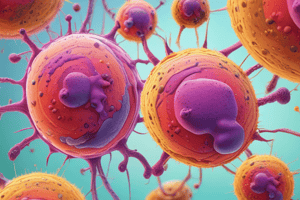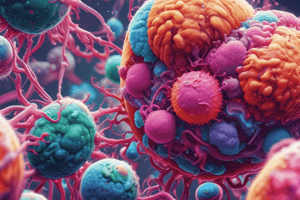Podcast
Questions and Answers
What characterizes a pathogen?
What characterizes a pathogen?
- A microorganism that aids in digestion
- A microorganism that can cause disease in a host (correct)
- A type of cellular structure found in all living beings
- A microorganism that is always harmless to humans
What occurs during an infection?
What occurs during an infection?
- The immune system completely eliminates all pathogens
- A pathogen successfully colonizes a host (correct)
- The body repairs itself
- The body's normal structure is enhanced
Which type of disease can be spread from person to person?
Which type of disease can be spread from person to person?
- Noncommunicable disease
- Iatrogenic disease
- Contagious disease (correct)
- Zoonotic disease
Which of the following is an example of a noncommunicable disease transmission?
Which of the following is an example of a noncommunicable disease transmission?
What influences the degree of contagiousness of a communicable disease?
What influences the degree of contagiousness of a communicable disease?
What type of disease is categorized as nosocomial?
What type of disease is categorized as nosocomial?
Which of the following diseases is zoonotic?
Which of the following diseases is zoonotic?
How can signs of illness be described?
How can signs of illness be described?
What is characterized by the absence of signs and symptoms, even though the pathogen has entered and started multiplying?
What is characterized by the absence of signs and symptoms, even though the pathogen has entered and started multiplying?
During which period do severe signs and symptoms occur?
During which period do severe signs and symptoms occur?
When might a person still be contagious after appearing to recover from an illness?
When might a person still be contagious after appearing to recover from an illness?
What type of disease is defined by a fast onset and a short duration of illness?
What type of disease is defined by a fast onset and a short duration of illness?
In which scenario would a pathogen be dormant but can reactivate due to stress or immunosuppression?
In which scenario would a pathogen be dormant but can reactivate due to stress or immunosuppression?
What type of pathogen may continue to shed after symptoms have resolved and spread person to person?
What type of pathogen may continue to shed after symptoms have resolved and spread person to person?
What characterizes the prodromal period of an infection?
What characterizes the prodromal period of an infection?
Which type of meningitis is contagious from the incubation for up to a week before the prodromal period?
Which type of meningitis is contagious from the incubation for up to a week before the prodromal period?
What term describes the degree of pathogenicity of a microorganism?
What term describes the degree of pathogenicity of a microorganism?
What is the ID50 for Norovirus?
What is the ID50 for Norovirus?
Which scenario could cause ID50 to vary significantly?
Which scenario could cause ID50 to vary significantly?
Which pathogen requires a higher number of cells to cause an active infection?
Which pathogen requires a higher number of cells to cause an active infection?
What does LD50 represent?
What does LD50 represent?
Which of the following pathogens is noted for having a low ID50 value?
Which of the following pathogens is noted for having a low ID50 value?
Which pathogen most often leads to severe symptoms with a higher mortality rate?
Which pathogen most often leads to severe symptoms with a higher mortality rate?
What is the ID50 range for Escherichia coli, enterohemorrhagic (EHEC)?
What is the ID50 range for Escherichia coli, enterohemorrhagic (EHEC)?
Flashcards
Pathogen
Pathogen
A microorganism that can cause disease in a host.
Infection
Infection
When a pathogen successfully colonizes a host.
Infectious Disease
Infectious Disease
Disease caused by a pathogen.
Communicable Disease
Communicable Disease
Signup and view all the flashcards
Contagious Disease
Contagious Disease
Signup and view all the flashcards
Noncommunicable Disease
Noncommunicable Disease
Signup and view all the flashcards
Zoonotic Disease
Zoonotic Disease
Signup and view all the flashcards
Iatrogenic Infection
Iatrogenic Infection
Signup and view all the flashcards
Incubation Period
Incubation Period
Signup and view all the flashcards
Prodromal Period
Prodromal Period
Signup and view all the flashcards
Period of Illness
Period of Illness
Signup and view all the flashcards
Period of Decline
Period of Decline
Signup and view all the flashcards
Period of Convalescence
Period of Convalescence
Signup and view all the flashcards
Acute Disease
Acute Disease
Signup and view all the flashcards
Chronic Disease
Chronic Disease
Signup and view all the flashcards
Latent Disease
Latent Disease
Signup and view all the flashcards
Virulence
Virulence
Signup and view all the flashcards
Avirulent
Avirulent
Signup and view all the flashcards
Highly virulent
Highly virulent
Signup and view all the flashcards
ID50
ID50
Signup and view all the flashcards
LD50
LD50
Signup and view all the flashcards
Factors affecting ID50
Factors affecting ID50
Signup and view all the flashcards
ID50 and disease severity
ID50 and disease severity
Signup and view all the flashcards
Examples of ID50
Examples of ID50
Signup and view all the flashcards
Study Notes
Microbial Mechanisms of Pathogenicity
- Pathogen: A microorganism that causes disease in a host.
- Infection: When a pathogen successfully colonizes a host.
- Infectious Disease: Disease caused by a pathogen.
- Communicable Disease: Spread from person to person.
- Noncommunicable Disease: Not spread from person to person.
- Examples of Noncommunicable Disease Transmission: Tetanus (skin wound), Legionnaires (breathing contaminated water).
Stages of Pathogensis
- Exposure (contact): Encounter with a potential pathogen (food, objects, etc.). Exposure does not always lead to infection. To cause infection, a pathogen must pass through a portal of entry (skin, mucous membranes, parenteral route).
- Adhesion: Pathogens attach to host cells via adhesion factors (e.g., pili, glycoproteins).
- Invasion/colonization: Pathogens invade host tissues. This is aided by exoenzymes and toxins that allow for colonization, damage, and spreading.
- Intracellular Pathogens: Get inside of cells, use host nutrients, and evade immune system.
- Examples of Invasion by H. pylori: The bacterium produces urease, which neutralizes stomach acid, allowing it to penetrate the stomach lining.
- Infection: The pathogen multiplies after its successful invasion. Infection can be local, focal, or systemic.
Infection: Local, Focal, and Systemic
- Local: Infection localized to the site of entry (boil around hair follicle, UTI in bladder, pneumonia in lungs).
- Focal: Infection spreads from the site of entry to a secondary location (cut in gums, spreading through blood).
- Systemic: Infection spreads throughout the body (Varicella Zoster through mucous membrane, upper respiratory tract and results in a rash).
Secondary Infections
- Opportunistic Pathogens: Pathogens that only cause disease in immunocompromised hosts.
- Examples of conditions impacting hosts: breaks in skin (wounds/burns), lowered immune system (AIDS), issues with normal microbiome, being young or old, pregnant, undergoing chemotherapy, recovering from surgery.
- Normal Microbiota: Can become opportunistic if the balance of the microbiome is disrupted.
- Example: E. coli moving from the gastrointestinal tract to the urinary tract can cause a UTI.
- Decreased Immunity: Fighting a primary infection can weaken the immune system, making it more susceptible to secondary infections.
- Example: Treatment with antibiotics can kill pathogens, but it also destroys the normal microbiome. This can lead to secondary infections..
Pathogen Exit
- To be transmitted to a new host, pathogens must exit the existing host (skin, respiratory tract, urogenital, GI).
Virulence Factors
- Virulence Factors: Promote pathogenicity and help pathogens adhere, invade and evade host defenses. Examples include adhesins, exoenzymes, and toxins.
- Adhesins: Help pathogens attach to host cells.
- Exoenzymes: Help pathogens penetrate host tissues, and damage cells.
- Toxins: Harm host cells and interfere with body functions.
Virulence Factors: Exoenzymes
- Hyaluronidase: Breaks down hyaluronic acid; allows pathogens to penetrate tissues.
- Nucleases: Break down DNA; allows pathogens to disseminate.
- Phospholipases: Break down phospholipids; breaks host cell membranes.
- Proteases: Break down proteins; can inactivate antibodies.
- Collagenase: Breaks down collagen; helps spread pathogens.
Virulence Factors: Toxins
- Endotoxins: Released upon pathogen death; stimulate inflammatory response or cause organ system failure
- Exotoxins: Proteins; often highly potent and deadly.
- A-B Toxins: Having two parts (A = activity, B = binding); A-toxin enters the cell and B-toxin binds to the receptor to the cell.
- Membrane-disrupting toxins: Create pores in host cell membranes or disrupt cell membranes.
- Superantigens: Trigger excessive immune responses, resulting in a cytokine storm.
Virulence Factors: Evasion of Phagocytosis
- Capsules: Prevent phagocytosis (immune cell engulfment).
- Proteases: Degrade host cell antibodies
- Fimbriae: Block binding to complement
- Antigenic Variation: Microbes alter surface proteins to avoid recognition. Examples include Lyme Disease (Borrelia burgdorferi), and influenza.
Other factors
- ID50: The infectious dose needed to cause an infection in 50% of infected animals.
- LD50: The lethal dose needed to kill 50% of infected animals.
- Opportunistic Pathogens: Only cause disease in an immunocompromised host.
- Period of Disease/Stages of Infection: Incubation: No signs or symptoms. Prodromal: Mild symptoms. Period of illness: Severe symptoms. Period of decline: Symptoms improve. Period of convalescence: Return to normal.
- Infants can contact pathogens during Pregnancy or Birth: Example, Chlamydia and Gonorrhea infections resulting in blindness in infants if not treated by eye antibiotics.
Studying That Suits You
Use AI to generate personalized quizzes and flashcards to suit your learning preferences.
Related Documents
Description
Test your knowledge on the mechanisms through which microorganisms cause disease. This quiz covers key terms such as pathogens, infection stages, and the types of diseases. Understand how pathogens invade host tissues and the factors involved in pathogenicity.




